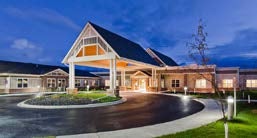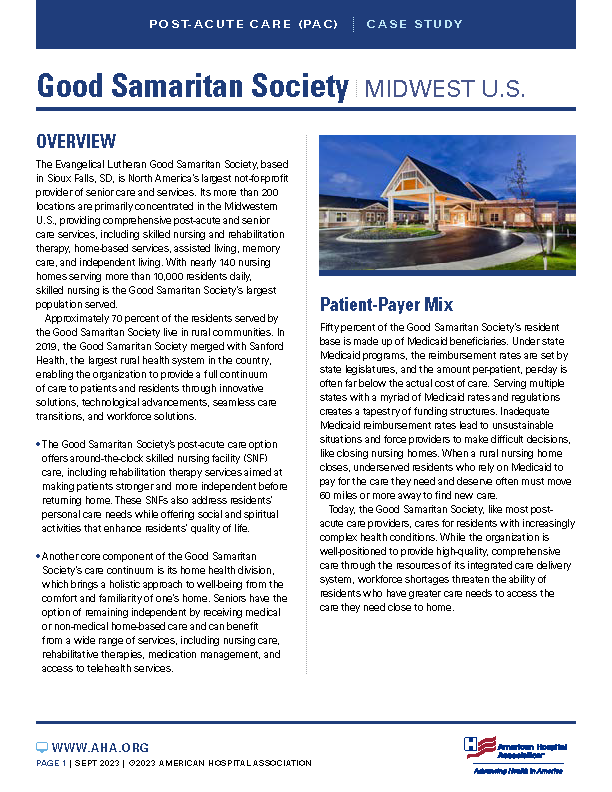

Good Samaritan Society | Midwest U.S.
Post-Acute Care CARE (PAC) | Case Study
Overview
 The Evangelical Lutheran Good Samaritan Society, based in Sioux Falls, SD, is North America’s largest not-for-profit provider of senior care and services. Its more than 200 locations are primarily concentrated in the Midwestern U.S., providing comprehensive post-acute and senior care services, including skilled nursing and rehabilitation therapy, home-based services, assisted living, memory care, and independent living. With nearly 140 nursing homes serving more than 10,000 residents daily, skilled nursing is the Good Samaritan Society’s largest population served.
The Evangelical Lutheran Good Samaritan Society, based in Sioux Falls, SD, is North America’s largest not-for-profit provider of senior care and services. Its more than 200 locations are primarily concentrated in the Midwestern U.S., providing comprehensive post-acute and senior care services, including skilled nursing and rehabilitation therapy, home-based services, assisted living, memory care, and independent living. With nearly 140 nursing homes serving more than 10,000 residents daily, skilled nursing is the Good Samaritan Society’s largest population served.
Approximately 70 percent of the residents served by the Good Samaritan Society live in rural communities. In 2019, the Good Samaritan Society merged with Sanford Health, the largest rural health system in the country, enabling the organization to provide a full continuum of care to patients and residents through innovative solutions, technological advancements, seamless care transitions, and workforce solutions.
- The Good Samaritan Society’s post-acute care option offers around-the-clock skilled nursing facility (SNF) care, including rehabilitation therapy services aimed at making patients stronger and more independent before returning home. These SNFs also address residents’ personal care needs while offering social and spiritual activities that enhance residents’ quality of life.
- Another core component of the Good Samaritan Society’s care continuum is its home health division, which brings a holistic approach to well-being from the comfort and familiarity of one’s home. Seniors have the option of remaining independent by receiving medical or non-medical home-based care and can benefit from a wide range of services, including nursing care, rehabilitative therapies, medication management, and access to telehealth services.
Patient-Payer Mix
Fifty percent of the Good Samaritan Society’s resident base is made up of Medicaid beneficiaries. Under state Medicaid programs, the reimbursement rates are set by state legislatures, and the amount per-patient, per-day is often far below the actual cost of care. Serving multiple states with a myriad of Medicaid rates and regulations creates a tapestry of funding structures. Inadequate Medicaid reimbursement rates lead to unsustainable situations and force providers to make difficult decisions, like closing nursing homes. When a rural nursing home closes, underserved residents who rely on Medicaid to pay for the care they need and deserve often must move 60 miles or more away to find new care.
Today, the Good Samaritan Society, like most postacute care providers, cares for residents with increasingly complex health conditions. While the organization is well-positioned to provide high-quality, comprehensive care through the resources of its integrated care delivery system, workforce shortages threaten the ability of residents who have greater care needs to access the care they need close to home.
Challenges
Workforce
The Good Samaritan Society has distinguished itself as an employer of choice through its mission and culture of care, as well as investments in employee well-being, flexibility, pay, benefits, training, and education. However, the COVID-19 pandemic accelerated staffing shortages across post-acute care settings at unprecedented levels. The Good Samaritan Society has experienced these challenges firsthand, which are compounded in deep rural areas where some communities go months without receiving an application for open RN, LPN, CNA, or key leadership positions. Because the Good Samaritan Society does not compromise on quality, staffing gaps are filled by traveling staff at three times the cost, or admissions are halted until more staff can be hired. Staffing challenges jeopardize the ability of seniors to access the care they need and deserve.
Regulatory Risks
While CMS considers implementing a minimum staffing requirement, the Good Samaritan Society considers that proposed policy to be the biggest risk facing post-acute care in decades - primarily because of the historic workforce shortages post-acute providers are grappling with and the untenable nature of an unfunded, one-size-fits-all mandate. The same rural facilities struggling to get applications for current open positions would be required to hire additional RNs and caregivers. The Good Samaritan Society is urging CMS to instead invest in solutions that help strengthen the post-acute care workforce and build a pipeline for tomorrow.
Payment Reductions
Continued reimbursement cuts and complex payment model changes will continue to place strain on quality providers’ ability to care for residents. In recent years, for example, SNFs and home health providers have undergone enormous changes with the Patient Driven Payment Model (PDPM) and the Patient Driven Groupings Model (PDGM), which have required providers to devote significant resources to navigate the new system. Moreover, a lag in reimbursement puts post-acute care providers at a gross disadvantage during times of high inflation because waiting to be reimbursed for care delivered can put providers on the precipice of closure. Providers are forced to look for creative ways to stay afloat, whether through diversification of services or continued mergers that allow for financial sustainability. As a largely rural provider, the Good Samaritan Society believes highquality care should be accessible to those who need it, regardless of their ZIP code.
Next Steps
To ensure residents and families have access to highquality care close to home, meaningful, long-term solutions and investments in workforce development must replace stop-gap measures, reimbursement cuts, and punitive regulations. Together with policymakers, post-acute care providers look forward to advancing solutions that ensure the stability and sustainability of our nation’s post-acute care system and the millions of older Americans who depend on skilled nursing facilities and home health care.
What is post-acute care?
Post-acute care is provided to a patient who is discharged from the acute-care hospital setting, but still requires services such as close medical supervision, nursing care, therapies, and other services. Medicare spending on post-acute care accounts for about $60 billion, or 15 percent, of Medicare spending every year (MedPAC, 2021).
The AHA's nearly 5,000 member hospitals, health systems, and other health organizations includes 3,300 post-acute care providers, including free-standing post-acute hospitals and post-acute units. Post-acute care settings include long-term care hospitals (LTCHs), inpatient rehabilitation facilities (IRFs), skilled nursing facilities (SNFs) and home health agencies.


